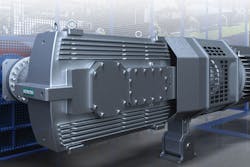7 steps to successful drive train installation
Taking the time and effort to thoroughly define all the parameters of a drive train leads to a successful integrated drive system (IDS) installation. Follow the seven steps in this article to meet customer requirements. reduce engineering time and ultimately ensure a successful drive train installation.
1. Define the application
The first step to any IDS is to define the customer’s application requirements. Having a thorough understanding of the requirements will help avoid one of the most common reliability issues: Lateral and torsional vibration due to resonances. To avoid vibration issues, the components should be selected and sized so there is sufficient margin between excitations from components and the natural frequency of the integrated system. The accuracy of this information provides the basis for Siemens IDS optimization efforts.
2. Define site requirements
When optimizing a system, it is essential to receive as much information as possible about the site where the system will be utilized. For example, ambient temperature swings or loading conditions could affect the performance of a drive system. In many indoor applications with climate control, special considerations are not required to ensure proper alignment and low vibration throughout ambient temperature swings from cold to hot. When the system is used outdoors with wide ambient air temperature swings, the motor and gearbox are not cooled by the same medium or are not of equal height to their respective foundations. Therefore, they will not grow at the same rate because of the ambient temperature swing. No matter the climate, there is always the potential for large ambient swings. Any differential between coupled machines must be considered and addressed. The supplier needs the product and application knowledge to properly design the entire system to solve these kinds of ambient air and temperature problems. Deviations from these conditions could require additional engineering efforts to satisfy the customer’s requirements and maintain system compatibility and efficiency.
3. Define system goals
When designing an IDS, it is important for the solution provider to understand the customer’s goals for the drive train. Some customers value a drive train with optimized price and reliability. Other customers value a drive train that can maintain high uptime despite the initial price increase. The solution provider must understand the values that an IDS can provide within the customer’s process and application before beginning to develop the optimized solution. In addition to cost minimization, the three key goals in any system design are reliability, availability and serviceability. These mainstays need to be analyzed to find the IDS solution for the customer with optimal functionality and price.
4. Define components
From the information gathered about the application and site requirements, the technical optimization experts should then define the proper components to develop the most cost-effective and reliable solution. Oftentimes each case can have multiple solutions using varying products that are engineered to work together. Key components are shown in Image 2.
5. Define optimization opportunities
Each combination of component, site and design requirements presents unique optimization potentials that the technical experts use to develop the optimal IDS for the customer. Ideally, an engineering team selects all relevant optimization opportunities based on an analysis of the customer’s system goals to ensure the IDS solution works as efficiently and reliably as possible. Some examples of optimization opportunities are listed in Table 1.
Size constraints may restrict the team from using a cheaper gearbox/drive and motor/drive combination and the customer may only have the space to use a motor/drive solution. Some manufacturers have portfolios that include options with variations of drives, motors and gearboxes. For example, the gearbox could be a low or high speed and the drive or motor could be a low or medium voltage option. All components need to be evaluated to find the correct mix for the best solution.
6. Analyze optimization opportunities
After defining the specific areas to be optimized, a team of engineers should complete an analysis of the defined optimization opportunities. This could include a site visit to analyze the vibration of a non-massive foundation, optimizing the oil film bearing design, choosing an optimal enclosure and cooling design to minimize installation and life cycle costs or performing a damped critical speed and stability analysis. This analysis involves in depth scrutiny of the proposed IDS system and the customer process and application. This analysis relies on the accuracy of the information provided to determine the correct design to suit each specific application.
7. Conduct factory acceptance testing
Many manufacturers test the components in the factory per customer request to ensure that the application requirements are met. Some examples of tests include gathering performance data at rated voltage and nominal speed, ensuring bearing temperature and vibration adhere to API 541 Standard, unbalance response tests and many more. Factory tests are another way to ensure component reliability for customers and that all requirements have indeed been met.
Ranjani Balasubramaniam is director, Program Office and Strategy, at Siemens Industry.





